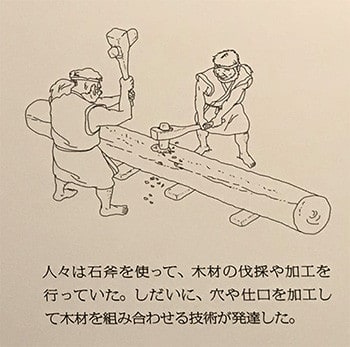



さてきのうはわが家周辺でのクマ出没情報で中断の日本のいい家シリーズ。
神戸の竹中大工道具館での展示・インスピレーションからの木造技術探検。
日本列島に人々が定住をはじめたのは縄文期から。
石器時代の痕跡も発掘されるけれどやはり文化と言えるのは縄文から。
とくに三内丸山遺跡が発見されて以降、その長期的な集落維持、
そして「社会の存在」「クリの栽培」など驚愕すべき歴史が掘り起こされた。
上の写真は三内丸山の物見櫓建築。
クリの巨木が6本立てられて復元されている。
木はあまりに巨大で復元に当たってはロシア極東奥地まで伐採に向かったという。
現在とはだいぶ様相の違う気候風土で温暖な気候だったとされる。
青森県青森市大字三内字丸山の縄文時代前期中頃から中期末葉の大規模集落跡。
沖館川右岸の河岸段丘上に立地する。一昨日には正式に世界遺産登録された
北海道北東北の縄文遺跡群の中心的な存在。
オリンピックが終わったら本格的にみなさん訪ねていただきたいと思います。
で、わたし的にはいまから1万年近い昔の木組み技術に深い興味。
写真は全景とその木組み箇所の拡大図なのですが、
復元としてはこのような木組み接合方法が提示されている。
たぶん相当の学術的検証、建築史的な知見も動員されて
このような方法が採択されたモノと思われます。
当時の道具は石斧の立て斧、横斧、その大小などが使われたと推定される。
挟んでいるイラストは竹中大工道具館展示であります。
石斧で巨木を切り倒していくつもの丸太をコロとして使って
伐採〜運搬したものと思われます。
石斧は日本列島に人類が進出するときには丸木舟は作られていたでしょうから
相当の人類的知見が集積していたことが確実視されます。
船にする為には伐採からくり抜きのプロセスで横斧である手斧が利用された。
その手斧を使えば、この接合部のような木組みが可能だったでしょう。
巨大柱の接合部付近に穴を掘り込みそこに受け材を差し込み横架材を受けた。
固定には樹皮ロープなどでグルグル巻き手法がとられたか。
個人的に気になるのが6本柱という点。
4本で構造させることはできるだろうと思いますが、
単純に平面を拡張させる意味合いかどうか。
6本を選ぶのにはなにか「民族性」がそこにあるのかと妄想させられる。
柱を立てる工法として「掘っ立て柱」工法が日本では進化している。
はるかな後年、わが家事務所で掘立電柱を列柱として立てたとき、
その奥行きに触れたような気がしたことを思い起こします。

古来から日本海沿いの南北間でいろいろな古代の交流が行われていた。
太平洋側と比べて波濤が穏やかで常に陸地を確認しながら航海できた、
環日本海交易圏で、縄文期にも活発な交流痕跡。
津軽海峡も後世居住民・アイヌの「塩っぱい川」という呼び名があるように
列島のまほろばとして、北海道北東北は列島での人間居住のマザーだった、
そんなように思われてなりません。この物見櫓と集会場のような大型竪穴住居。
先人たちのはるかな建築営為が新鮮な感動を呼び起こしてくれます。
English version⬇
[Japanese wooden frame travelogue-Jomon / Japanese good house ㊳-1]
A series of good Japanese houses that were interrupted by information on the appearance of bears around my house.
Exploration of wooden technology from exhibition and inspiration at Takenaka Carpentry Tools Museum in Kobe.
People began to settle in the Japanese archipelago from the Jomon period.
Traces of the Stone Age are also excavated, but it is still from the Jomon period that it can be said to be a culture.
Especially since the discovery of the Sannai Maruyama Site, its long-term settlement maintenance,
And astonishing history such as "existence of society" and "cultivation of chestnuts" was unearthed.
The photo above is the Sannai Maruyama turret architecture.
Six giant chestnut trees have been erected and restored.
It is said that the trees are so huge that they went to the interior of the Russian Far East for logging.
It is said that the climate was warm with a climate that was quite different from the present.
A large-scale settlement trace of leaves from the middle to the end of the middle of the Jomon period in Maruyama, Oaza Sannai, Aomori City, Aomori Prefecture.
It is located on the river terrace on the right bank of the Okidate River. Officially registered as a World Heritage Site the day before yesterday
The central existence of the Jomon archaeological site in the northeastern part of Hokkaido.
I would like everyone to visit us in earnest after the Olympics.
So, personally, I am deeply interested in the woodworking technology of nearly 10,000 years ago.
The photo is an enlarged view of the whole view and its timber frame.
As a restoration, such a wooden frame joining method is presented.
Perhaps considerable academic verification and architectural historical knowledge were also mobilized.
It seems that such a method was adopted.
It is presumed that the tools used at that time were the vertical ax of the stone ax, the horizontal ax, and the size of the ax.
The illustration in between is the Takenaka Carpentry Tools Museum exhibition.
Cut down a giant tree with a stone ax and use a number of logs as rollers
It seems that it was cut down and transported.
The stone ax would have been a dugout canoe when humans entered the Japanese archipelago.
It is certain that a considerable amount of human knowledge was accumulated.
A hatchet, a horizontal ax, was used in the process of logging and hollowing out to make a ship.
With that hatchet, it would have been possible to build a wooden structure like this joint.
A hole was dug near the joint of the huge pillar, and a receiving material was inserted there to receive the horizontal material.
Was the method of wrapping around with a bark rope etc. taken for fixing?
I personally care about the six pillars.
I think it would be possible to make it with four, but
Does it mean simply expanding the plane?
It makes me wonder if there is any "ethnicity" in choosing six.
The "digging pillar" construction method is evolving in Japan as a construction method for erecting pillars.
A long time later, when I set up a digging utility pole as a colonnade at my office,
I remember feeling like I was touching that depth.
Since ancient times, various ancient exchanges have been held between the north and south along the Sea of Japan.
Compared to the Pacific side, the waves were calm and I was able to sail while always checking the land,
Traces of active exchange during the Jomon period in the Pan-Japan Sea trade area.
The Tsugaru Strait is also called the "salt river" of the Ainu, a posterior resident.
As a mahoroba of the archipelago, northeastern Hokkaido was the mother of human settlement in the archipelago,
It shouldn't seem like that. A large pit-house like this turret and assembly hall.
The far-reaching architectural activities of our predecessors evoke a fresh impression.



















